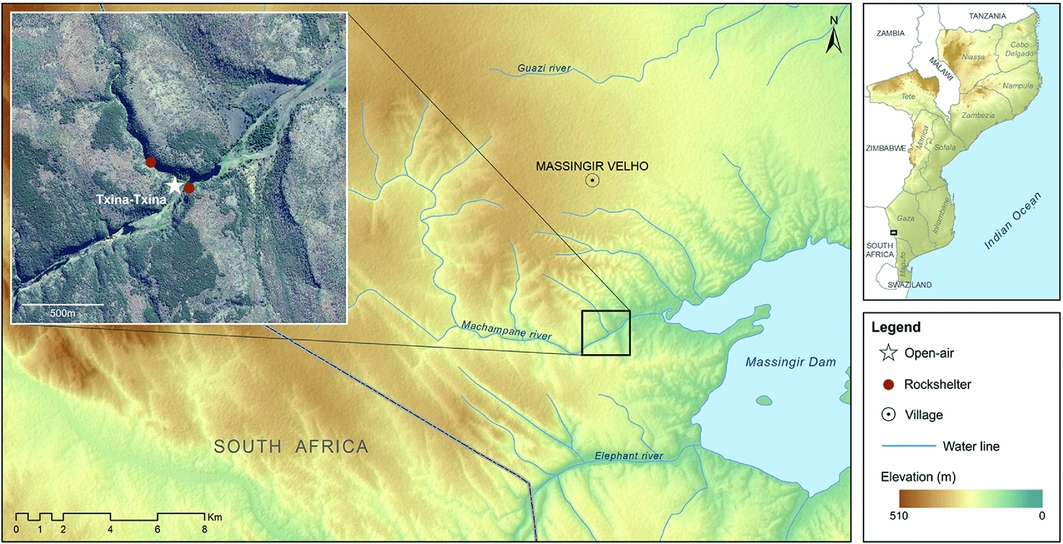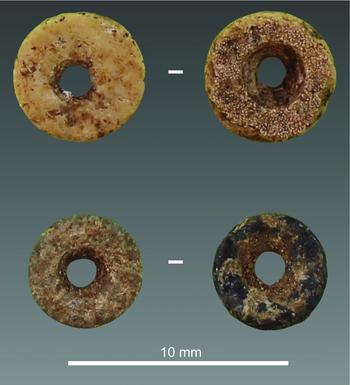South-east Africa is an important region for gaining a better understanding of the development of Stone Age and anatomically modern humans. Mozambique, for example, is receiving increased research attention (e.g. Mercader et al. Reference Mercader, Asmerom, Bennett, Raja and Skinner2009; Ekblom et al. Reference Ekblom, Notelid and Sillen2015), as it is located between one of the earliest finds of anatomically modern humans (in Ethiopia) and South African sites with early evidence for cognitive complexity.
In 2011, we started fieldwork in various regions of Mozambique, including at Lake Niassa, the Limpopo Basin in the Massingir area and on the southern coast (Bicho et al. Reference Bicho, Cascalheira, Haws, Gonçalves and Raja2016; Gonçalves et al. Reference Gonçalves, Raja, Madime, Cascalheira, Haws, Matos and Bicho2016). Non-systematic survey concentrated on specific areas where geomorphology and geology increased the chances of discovering open-air and cave/rockshelter Stone Age sites. The team was able to locate over 200 new sites. Since 2015, we have worked in the Massingir area, in the Elephant River Valley. Here, we have found mostly Middle Stone Age sites. Approximately 20km to the west, in the Machampane Gorge, however, we discovered a number of Later Stone Age sites (Table 1) with long stratigraphic sequences (Figure 1). One of these is Txina-Txina (Figure 2). This site is over 2500m2 in area and is located on a small fan, which forms out of the Chifati stream (then runs to the Machampane River).
Table 1. Radiocarbon dates from Txina-Txina.

* Calibration using OxCal 4.3.2 (at 95.4% probability; Bronk Ramsey Reference Bronk Ramsey2009). Southern hemisphere ShCal13 calibration curve (Hogg et al. Reference Hogg, Hua, Blackwell, Niu, Buck, Guilderson, Heaton, Palmer, Reimer and Reimer2013).

Figure 1. Map of the region with the location of the site of Txina-Txina.

Figure 2. General view of Txina-Txina, with the Machampane River on the right side (photograph by Nuno Bicho).
The approximately 5m-deep sequence is marked by two main phases: the bottom 3m comprises a fluvial terrace, overlain by 2m of fine colluvium containing occasional boulders from the exposed bedrock slope. We excavated three 1m2 test pits to the bottom of the colluvium, revealing an anthropogenic sequence radiocarbon dated to between c. 31 ka cal BC (Table 1) and the Iron Age. Thousands of lithic artefacts were recovered, preliminary analyses of which indicate that the assemblage is based on flake production using centripetal, unidirectional and bipolar technologies, as well as bladelet production from bipolar and prismatic cores. Formal tools are rare, but there are a few crescents based on microburin technology (Figure 3), backed bladelets, scaled pieces, denticulates and notches. Raw materials mostly comprise rhyolite, quartzite, quartz and cherts, and all seem to be of local origin. Although rare, we also found a few bone fragments from small mammals.

Figure 3. Crescents (a–e) and microburins (f–g) from Txina-Txina (photograph by João Cascalheira).
More interesting, however, are the well-preserved remains of terrestrial and freshwater gastropods, and ostrich eggshells (OES) (Table 2). We recovered 385 gastropod shell fragments, the majority from Achatina sp., a few from Chambardia petersi and two complete Melanoides tuberculate shells. The most important fragment is an engraved Achatina piece, approximately 15mm2, with criss-crossing parallel lines (Figure 4). This was recovered from the lowest level of unit AA88, associated with the radiocarbon dates in Table 1, and with a chronology prior to the Last Glacial Maximum. This is a unique find in Mozambique and is probably very rare in the Southern Africa early Later Stone Age. We also recovered 28 OES fragments and two OES beads (Figure 5), the latter of which were perhaps in a late production phase (Kandel & Conard Reference Kandel and Conard2005). One of these beads is possibly burnt. While such beads are known from a few late southern African Middle Stone Age and early Later Stone Age sites (Miller & Willoughby Reference Miller and Willoughby2014), these are the first to be recovered from a Stone Age context in Mozambique.
Table 2. Organic remains from Txina-Txina.


Figure 4. Engraved shell fragment from Txina-Txina (photograph by Lino André)

Figure 5. Ostrich eggshell beads from Txina-Txina (photograph by Lino André).
The engraved shell fragment and the OES beads from Txina-Txina date to between Heinrich Events 3 and 2, roughly between 34000 and 25000 years ago. These finds, in combination with the long stratigraphic sequence and the lithic assemblage, make this site one of the most important locations for studying the Middle Stone Age to Later Stone Age transition in Mozambique, and certainly relevant for that period in all of Southern Africa. Long-term excavations at Txina-Txina are planned to start in 2019, and at other Later Stone Age sites in the Machampane Gorge, including at least two rockshelters and two open-air sites.
Acknowledgements
We would like to thank Fundação para a Ciência e Tecnologia (grants PTDC/EPH-ARQ/4998/2012 and PTDC/EPHARQ/4168/2014) and the National Geographic Society for funding the research in Mozambique (Waitt grants—W373.15 and HJ-033R-17). Permits were issued by the Direcção Nacional do Património Cultural, Maputo.









